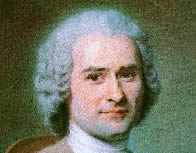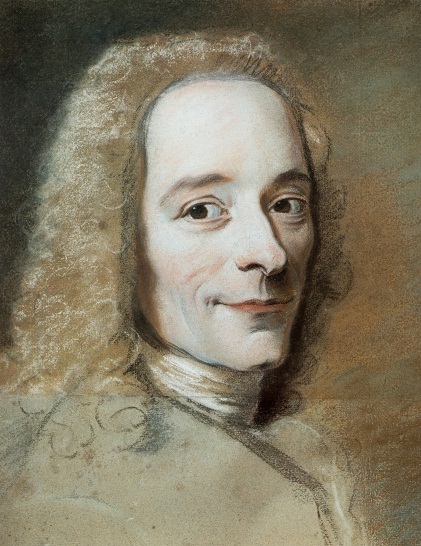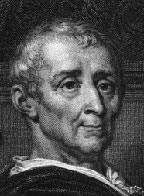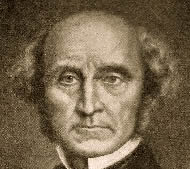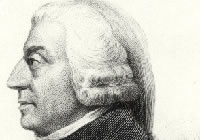UNIT TWO: FOUNDATIONS OF LIBERALISM
| Site: | MoodleHUB.ca 🍁 |
| Course: | Social 30-1 RVS |
| Book: | UNIT TWO: FOUNDATIONS OF LIBERALISM |
| Printed by: | Guest user |
| Date: | Tuesday, 30 December 2025, 6:45 PM |
Table of contents
- 1. OVERVIEW
- 2. Concepts and Terms
- 3. Origins
- 4. Aboriginal Contributions
- 5. Quiz 2.1: Haudenosaunee
- 6. Studying Classical Liberalism
- 7. Classical Liberal Ideas
- 8. Other Classical Thinkers
- 9. Political and Economic ideas
- 10. Limited Government
- 11. The Industrial Revolution
- 12. The French Revolution
- 13. The American Revolution
- 14. Impacts on 19th Century Society
- 15. SUMMARY
- 16. SUMMATIVE EXAM 1
1. OVERVIEW
The Foundations of Liberalism

Do you ever think about the society you live in? Do you think about the rights and freedoms you enjoy?
Today, many Canadians take their fundamental rights and freedoms for granted. But Western society has not always valued the contributions of all people. People were not always allowed to make their own choices. In fact, it was believed that people were not able to make decisions for themselves; those decisions were made by the Church or a local nobleman. Men and women have not always been considered equal, nor was the the right to vote allowed for both rich and poor. Children did not have rights, nor did people of religious and ethnic backgrounds different from the majority.
In fact, in many societies in the past, many believed that certain people had the god-given right to rule. It was believed that only some people had the intelligence or authority to make many of the decisions we make today, such as who should have power or how a nation's money should be spent.
- How did peoples' values and beliefs shift?
- How did European society move from a class structure ruled by those with inherited power or the biggest army to one that values equality and democracy?
- How did the Church lose its power?
- How has our world developed the political and economic systems it has today?
You will learn about the ideas, people, and societies that pioneered many of the principles of liberalism. Then, you will familiarize yourself with the concept of liberalism that developed in Western Europe and America during the 18th and 19 th centuries, and you will discover how these theories were put into practice.
You will evaluate the impact of 18th and 19th century liberalism. You will identify the successes and failures that resulted from the practical applications of liberal ideology.
-
How did individualist ideas ideas emerge as liberalism? Where did they originate?
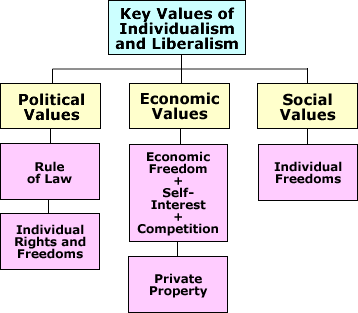
This unit has two sections:
- What are the origins of liberalism? (Before Liberalism, Fundamental Ideas about Human Nature, Classical Liberal Thinkers, Political and Economic Ideas)
- What was the impact of classical liberalism? (Industrial Revolution, Revolutionary Change, Limited Government, Changes to the Class System)
2. Concepts and Terms
Foundations of Liberalism Concepts and Terms
Unit Question: How did liberalism originate?
Issue Question: To what extent is resistance to liberalism justified?
In this unit, you will explore the following big ideas based on questions arising from the issue question:
- What is classical liberalism?
- What ideas about the nature of human beings influenced classical liberalism?
- What was the impact of classical liberalism?
This is a list of new terms you will encounter in this unit.
competition
constitution
direct democracy
divine right of kings
enlightenment
free market
Great Law of Peace
invisible hand
humanism
laissez-faire capitalism
progressivism
mercantilism
rule of law
self-interest
social contract
tyranny of the majority
People Make History! Especially these thinkers who contributed to Classical Liberal thought:
Baron de Montesquieu
John Locke
Thomas Hobbes
3. Origins
Early Origins of Liberalism
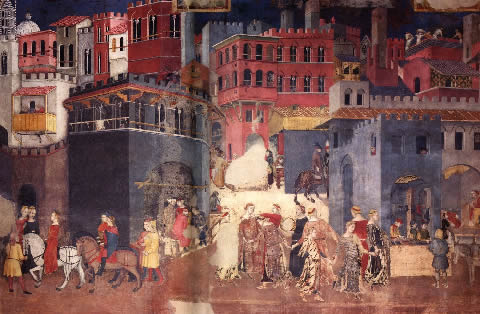
Ambrogio Lorenzetti's fresco Allegories of the Good and Bad Government, painted in the 14th century, was designed to remind the government of his Italian city-state what the role of government should be.
Good Government is dominated by an enthroned figure representing the commune, which is flanked by the Virtues. Bad Government is ruled by Fear and a scroll that reads "Because he looks for his own good in the world, he places justice beneath tyranny. So nobody walks this road without Fear: Robbery thrives inside and outside the city gates."
In the next few pages, you will learn about how the ideas behind classical liberalism changed the Western world. These ideas were in part a reaction to the political and economic systems of the day, systems that many people felt were outdated and based on faulty premises. What was the world like before liberalism?
In reality, royalty and nobility earned their power through warfare, economic power, and strategic alliances with other powerful rulers and countries. The average person who lived in Europe had little or no say in the decisions that affected his or her daily life. Men and especially women and children were not guaranteed any fundamental rights and freedoms we experience today. Governments had a great deal of power over people's lives.
One of the earliest documents in the development of the rule of law and the establishment of individual rights and freedoms was the Magna Carta. Signed in Great Britain in 1215, it limited the powers of the king and established fundamental rights for citizens.

Democracy in Ancient Greece had many similar aspects to our modern democracy. Athens is often thought of as the first democracy. The word democracy is derived from the ancient Greek word demos kratia, which means "the people rule". But how democratic was it?
Twelve percent of the people of Athens had the right to participate in the democratic decision-making process. Only male "citizens" were eligible to attend assembly meetings. Women, the foreign-born, slaves, and others were excluded from the process. Athenians were allowed to keep slaves, and the rights of Athenian women were restricted.
Athens' short-lived direct democracy required 40 or more meetings of the governing assembly per year, so not all eligible citizens could attend regularly. On average, only one-sixth of those eligible to vote showed up at a given meeting.
Although citizens had the right to vote on public policy, they did not vote to decide who would implement those policies. Instead, political officers were selected by drawing lots. This government-by-luck-of-the-draw approach was not particularly democratic.
Under mercantilism, monarchs granted certain merchants, friends, relatives, or companies licences to operate their businesses and to trade abroad. Granting privileges to certain businesses created monopolies. These monopolies limited the availability of goods and drove up prices. Competition was almost non-existent. Monarchs filled their treasuries by selling licences and by taxing the merchants and companies that profited under this system. Monarchs also accumulated wealth in the form of gold bullion by restricting the flow of money out of the country and by taxing goods being imported.
This meant that many individuals did not have the freedom to make a profit from hard work, new ideas, or taking risks.
- How did liberalism emerge as an ideology?
4. Aboriginal Contributions
Aboriginal Contributions to Liberalism
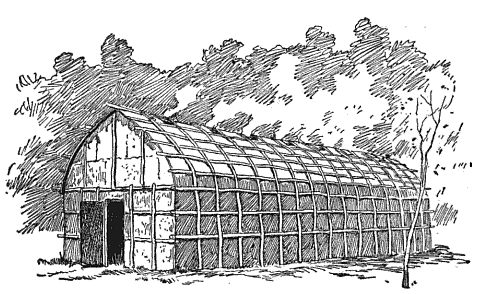
A drawing of an Iroquois Longhouse. It promoted collectivism by housing a number of families under the same roof.
However, the Aboriginal peoples of North America had their own traditions and ideologies. To what extent were their practices liberal?
The Haudenosaunee, also known as the Iroquois, are considered to be one of the longest continuously existing participatory democracies in the world. According to oral tradition, the confederacy has been in existence since the beginning of time. Archaeological evidence goes back to the 15th century.
The Iroquois also refer to themselves as the Haudenosaunee, which means "People of the Longhouse", implying that the six nations should live together as families in the same "house" under the same rules.
These First Nations people had been at war with each other for centuries until they decided to come together, all agreeing to abide by the Great Law of Peace. The Great Law of Peace, or Great Binding Law, was their oral constitution. It laid out the way to peace and harmony among the nations. Its key principles included:
- division of powers among various branches of government
- equal participation by citizens, including women
- establishment of rights and freedoms, including freedom of speech, religion, and rights of the individual
The various nations of the confederacy came together in a strong and powerful association known as the Six Nations, including the following First Nations:
- Kanien'kehaka (Mohawk)
- Oneniote'a:ka (Oneida)
- Gan'dagwëni:io'geh (Onondaga)
- Kaion'keha:ka (Cayuga)
- Shotinontowante'a:ka (Seneca)
- Tehatiskaro:ros (Tuscarora)
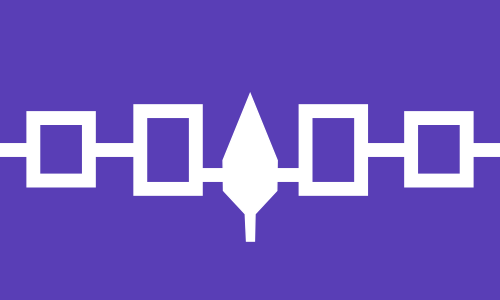

The Great Law of Peace was an oral constitution with democratic principles. Many historians consider it to have been an inspiration to men such as Benjamin Franklin and Thomas Jefferson who knew the Haudenosaunee and were impressed by the way they ran their nations. These men helped write the constitution of the United States. Consider the following similarities:
| The Great Law of Peace | Constitution of the United States of America | |
|---|---|---|
| Preamble |
|
|
| Choice of leaders |
|
|
| Equality |
|
|
| Division of Powers |
|
|
When the first Europeans arrived in North America, the Haudenosaunee were based in what is now the northeastern U.S. The Confederacy ended with the American Revolution. At that time, many Haudenosaunee moved north to Canada when the land granted to them by the British was taken over by American settlers.
5. Quiz 2.1: Haudenosaunee
Please head over to the 2.1 quiz found in the unit tab and complete. Let me know if you have any questions!
6. Studying Classical Liberalism
Why Study Classical Liberalism?
These rights and freedoms are relatively new in the history of mankind. In the days of our ancestors, people did not experience the kinds of liberty we do today. In many countries, they were born into a certain social class and could not move out of it. Men were not considered equals to all other men, and women were not considered equals to men or to women of higher social classes. They could not own property, and people without property could not vote.
The girl in the image worked in the cotton mills of the United States in the 1800s. Consider the details in the photo that tell you something about her life.
- What rights and freedoms do you think she had?
- What has changed in our world so that young children are not forced to work in unsafe factories for very little pay?
- Or has our world changed that much?
Our political and economic systems in Canada were influenced strongly by those in Europe where the ideas of classical liberalism originated. The focus of this unit is the development of classical liberalism in Europe and North America, which formed the basis of Canada's economic and political institutions.


- What were the early experiments with classical liberal ideas?
7. Classical Liberal Ideas
Crafting Classical Liberal Ideas
As you learned in the previous unit, one of the determining characteristics behind any ideology is a belief about the nature of human beings. During the past 500 or so years, individualism emerged as a central tenet of political and economic theory that challenged the absolute monarchies and mercantile economies of Western Europe.
- Are people born essentially good or evil? How does society shape human behaviour?
- Will individuals only act in their own self-interest, or are they willing to make sacrifices for the well-being of their community?
As a result, the ideology of classical liberalism emerged from these ideas about the primacy of individual decision making in society. This unit examines this slow but steady evolution.
In the Middle Ages in Europe, almost all people had a powerful belief in God. According to the teachings of the Church, people were weak and sinful and needed the saving grace of the Church. It was also believed that those in positions of power were there because they deserved to be. Those ideas changed with the Renaissance and the Reformation.
Renaissance (14th-16th C) means "rebirth". It was a time of great social, intellectual, political, and artistic change in European history, often seen as a bridge between the Middle Ages and modern times. The Renaissance Humanists believed in individual human worth and dignity. They believed in reason over faith. They thought that people choose their own nature-a great departure from the common thinking at the time that a person's true nature was divined by a higher power.
Reformation (1517-1648) is the name given to the restructuring of the Church in Europe. It began with a German pastor (Martin Luther) who believed the Church had become corrupt and had too much power. He and others felt that the Church had strayed from its true purpose and demanded that it be reformed. Influenced by humanism, over the next years, reformers in many countries broke away from the established Roman Catholic Church and constructed new denominations according to various ideas, especially the idea that people were capable of making their own decisions based on reason. At this time, the power of the Church waned and faith in the rational nature of human beings grew.
Age of Enlightenment (17th-18th C) - As the ideas of the Renaissance and Reformation became more popular, European philosophers helped promote the ideas about human nature that led to the development of classical liberalism.
Watch this video to learn how individualism, and subsequently classical liberal ideas, emerged during this time.
The following writers became famous for promoting certain liberal ideas. Click on each hyperlinked name to learn more about these contributions. Then, use the organizer below to take notes.
|
Thomas Hobbes
|
John Locke
|
Jean Jacques Rousseau
|
Although Hobbes, Locke, and Rousseau had various ideas about the nature of human beings, one thing they all agreed upon was "the social contract". They agreed that, no matter what human nature is truly like, we all live in an organized society in which we must agree to give up some of our freedoms in return for benefits such as good government and personal security.
After reviewing the Hobbes, Locke and Rousseau pages that identify in detail, their beliefs, watch this video to compare all three:
- What are the main ideas about human nature held by this thinker?
- What kind of society will result from these ideas?
- What events or ideas influenced his perspective?
- Which individualist ideas contributed to the ideology of classical liberalism?
8. Other Classical Thinkers
Other Classical Liberal Thinkers
Between the 1600-1800s, movements from the Reformation to the Renaissance in Europe led to a greater belief in the importance of the individual and the power of reason. These two movements led to what is known as the Enlightenment, or Age of Reason. During this time, a disparate group of people began to question certain social, political and economic ideas.
- if people are essentially self-interested, do they need a system to impose order and control?
- If people are good, should they not have freedom to do what they want?
- If people are equal, should they not have equal rights, freedoms, and responsibilities?
A few of the most prominent classical liberal thinkers are below. Each one provided fundamental ideas that led to the development of classical liberal thought. Click on the hyperlink of each name to learn more about their ideas and contributions. While reading, complete the organizer available below.
|
Voltaire
|
- You will need to understand their contributions in an upcoming discussion forum.
- What are humans like? Is human nature mostly good or bad?
- What is, and should be, the structure of society?
- What is our role as citizens in society?
- What should be the role of government be in the lives of its citizens?
9. Political and Economic ideas
Specific Political & Economic Ideas
Classical Political Liberalism
The word politics refers to how power is distributed in society, including the powers of government. You have learned about the Western world before the ideas supporting classical liberalism came about. Specifically, what did these new ideas
mean in terms of the distribution of power and the role of government?
In Social 20-1, you learned about the Enlightenment philosophers of France who rejected the idea of themselves as subjects of a king and replaced the concept with the idea of being citizens of a nation. Although the French Revolution was a nationalist movement, it was also a liberal movement. It represented a rejection of absolute rule by one individual in favour of rule by a government of the people. It replaced a social and governmental system based on heredity, privilege, and ties to the Church with one based on equality and rights. It replaced the substantial powers of the existing government with more limited government.
During the Enlightenment, many philosophes (French economists) questioned traditional ideas, including the existence of God, God's role in human affairs if He did exist, and the right of the king to rule over his subjects with absolute power.
Their ideas about human nature led them to believe that individual people should hold power in society by deciding who should rule. By challenging centuries-old ideas about government and the monarchs' right to rule,
the thinkers of the Enlightenment laid the groundwork for the overthrow of many of Europe's monarchies. These monarchies were replaced eventually by liberal democracies.
Classical Economic Liberalism
Classical liberal thought also produced economic change. Economics, sometimes called "the dismal science", refers to the study of the production, distribution, and consumption of goods and services. In other words, it is about money!
As you learned, mercantilism was a system in which certain individuals and corporations operated with favoured status from the government. The ideas behind classical liberalism encouraged people to believe that the government should leave them alone to go about their business in a free market. In French, the term laissez-faire means "to leave alone".
Competition among consumers for products, among businesses for consumers' dollars, among workers for jobs, and among employers for skilled workers would make the economy self-regulating. Smith referred to this as the invisible hand.
As individuals strove to better their own economic situation, the economy of the nation as a whole would also benefit.
Adam Smith, The Wealth of Nations (1776)
Classical liberals had a far more expansive understanding of the term minimal government interference than exists today. As capitalist ideals became popular, there was little government regulation or oversight of business or business practices.
- What are the main ideas about the economy held by Adam Smith?
- What events or ideas influenced this perspective?
- How did these ideas contribute to the principles of classical liberalism?
After reviewing your notes, what have you learned about the guiding principles of classical liberalism?
Your summary should include the following points:
- A belief that people are essentially reasonable (rationale) and deserve the right to make personal decisions to benefit themselves and society
- A belief in the importance of the individual above all else
- A belief in individual rights and freedoms that should be enjoyed for the self-interest of the individual
- A belief in economic freedom, including the free market
- A belief in the protection of civil liberties
- A belief in constitutional limits to the power of government (rule of law)
10. Limited Government
The Concept of Limited Government
What role should government have in people's lives?

The French and American Revolutions occurred for several reasons. One of the most significant was a reaction to the role government had in the lives of the people. The French government and the British government that ruled the U.S. prior to its independence were based on a class system; they were governments that taxed their people heavily without allowing them any significant role in return.
Remember that ideologies have both political and economic aspects. Liberalism advocates a greater role for individuals in both the power structure and the economic structure of a nation.
Political Classical Liberalism
The revolutions in France and the United States saw a shift in the power base of these two nations. Instead of political power being held by the monarch and a handful of noblemen, it was invested in citizens who were empowered to influence the actions
of government by voting for representatives. It took longer for this power to be equally shared by all men and women, but this was a start on the road to more power in the hands of the individual. This shift occurred gradually in all nations of Europe
and, over a longer period of time, in most of the world today.
Economic Classical Liberalism
A desire to limit the power of the government in economic affairs of the nation is a key principle of classical liberalism. Adam Smith's idea of the invisible hand led to the development of free markets and encouraged entrepreneurship. Under classical
liberalism, governments taxed less, provided fewer advantages to local businesses and encouraged individuals to own and operate almost all programs and services in a country for their own profit.
Concept of Limited Government
Because many societies like France and United States rid themselves of an absolute monarch, classical liberals supported the notion of limited government involvement both politically and economically. The government's role is only to provide public security and essential services such as road maintenance and primary education. You will consider the changing role of government in the lives of its citizens in the next unit.11. The Industrial Revolution
The Industrial Revolution
Due to the promotion of classical liberalism, the economic structure of Britain, than the rest of the Western world, underwent a dramatic transformation.
The movement from feudalism to industrialization was largely a result of societies adopting classical liberal economic principles. Although eventually it brought huge changes in the lives of most people, change did not come without a cost. Examine carefully the drawing on the left. It depicts the living conditions of people during the Industrial Revolution in Great Britain.
The Industrial Revolution occurred in Great Britain from about 1750 to 1900 and spread to the remainder of the world. It is called a revolution not because it involved warfare or bloodshed but because it resulted in extreme changes in the social, economic, and political aspects of the lives of all citizens.
Several factors contributed to the Industrial Revolution:
Does it seem like a world based on the fundamental principles of liberalism?
- rule of law
- individual rights and freedoms
- private property
- economic freedom
- self-interest
- competition
In the next unit, you will read about how society responded to the immediate effects of classical liberal principles being promoted during the Industrial Revolution.
12. The French Revolution
The French Revolution
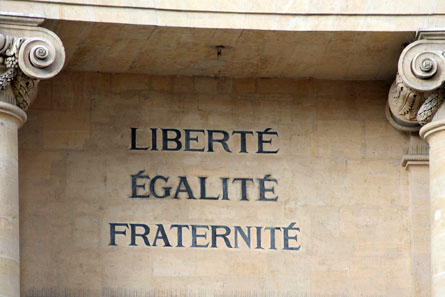
The image on the left reads Liberté, Égalité, Fraternité. Freedom, Equality, Brotherhood was the rallying cry of the French Revolution.
As classical liberalism evolved, it brought many economic, political and social changes. One such political experiment with classical liberal ideas was in France.
Before 1789, French society was divided into a rigid feudal structure in which the nobility and members of the Church enjoyed privileges not held by regular citizens. They had more money and more power at the expense of the majority of the population.
Leading up to 1789, the French government was in financial trouble, partly due to the lavish spending of the absolute monarch, and partly because it drained its treasury to help American Revolutionaries fight the British. France was involved in a long-standing battle with Great Britain, and success of the Americans over the British would weaken British power.
Political accountability was virtually non-existent, and when the King did ask for help, he sought support from the small number of clergy and aristocracy. Making matters worse, a nation-wide drought led to poor bread yields and starvation in the year before 1789. Peasants went further into debt trying to pay feudal dues to their aristocratic landlords.
Royalty in France had very little understanding of the poverty and frustrations experienced by the third estate, or majority of French citizens. One legend claims that French Queen Marie Antoinette famously replied "Let them eat cake" after hearing the peasants had no bread.
A class structure based on injustice and lack of accountability helped fuel a revolution that led to massive changes in French and later European societies.

Caricature of the Third Estate carrying the First Estate (clergy) and Second Estate (nobility) on its back.


The resulting revolution attempted to incorporate individualism into political and social structures, but ultimately led to turmoil and chaos. It is important to understand the examples of classical liberalism at play, and how
- Read pages 114 to 115 and 118 of your text Perspectives on Ideology.
13. The American Revolution
The American Revolution
Classical liberalism also contributed to the creation of the United States of America, otherwise known as the American Revolution, which occurred between 1775-1783.
Before this, the 13 colonies along America's east coast had local governments, but under the the control of Great Britain. American settlers had to pay British taxes, as well as tariffs on imported goods.
They did not want to be ruled from a government from abroad and declared themselves independent from Great Britain with the "Declaration of Independence" that established a republican form of government in which authority to rule came from the citizens, and not a foreign monarch.
Bolstered by enlightenment thinkers such as Thomas Paine and John Locke, they set out to establish political autonomy and economic freedom from British control. On the right hand side is Thomas Paine's original pamphlet entitled Common Sense, which was immensely popular in the United States when published in 1776.
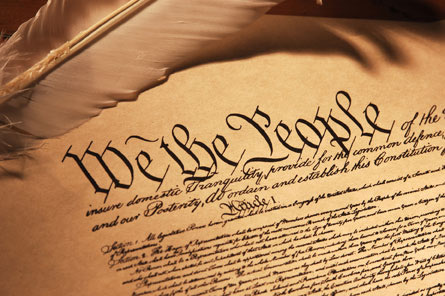


14. Impacts on 19th Century Society
Impacts on 19th Century Society
Thanks to the promotion of classical liberal principles, the idea of rigid class system began to die away, and a social structure based on wealth began to emerge. Due to the pursuit of self-interest, private property and economic competition, people could
improve their social and economic status. Hard work and self-reliance were encouraged as keys to economic success.
While greater political equality was encouraged, in many countries, this expansion of suffrage or voting rights included
only men who owned property. In fact, the expansion of suffrage for men alone took several decades in Britain, Canada and the United States. For example, the U.S. and France, two nations founded on the idea of "equality", did not grant all women
the right to vote until 1920 and 1945 respectively.
15. SUMMARY
Unit Two Summary
Unit Two explores the development of classical liberalism.
Classical liberalism is an ideology that continues to influence Western society both politically and economically. As you review the concepts in this unit, consider the themes and characteristics of an ideology.On what themes and characteristics is classical liberalism based?
Themes |
|---|
|
Characteristics |
|---|
|
|
|
|
|
Industrial Revolution
French Revolution American Revolution |
All contributed to changes in how people lived, including the power people had over their own lives and who made the political and economic decisions that impacted society.
In the next unit, you will investigate how people responded to changes that arose in society because of classical liberal ideology.
Although classical liberalism brought many positive changes, it also presented challenges. From what you have learned, can you see any reasons people might disagree with classical liberalism? Is it missing any of the key values in which you believe?
16. SUMMATIVE EXAM 1
Please review all of your notes, readings, and vocabulary you have learned up until this point. Once you feel you are ready, you can attempt your first summative exam of the course. You will need permission to write this exam and you will need to be supervised at your school or campus.
Please let me know if you have any questions!


